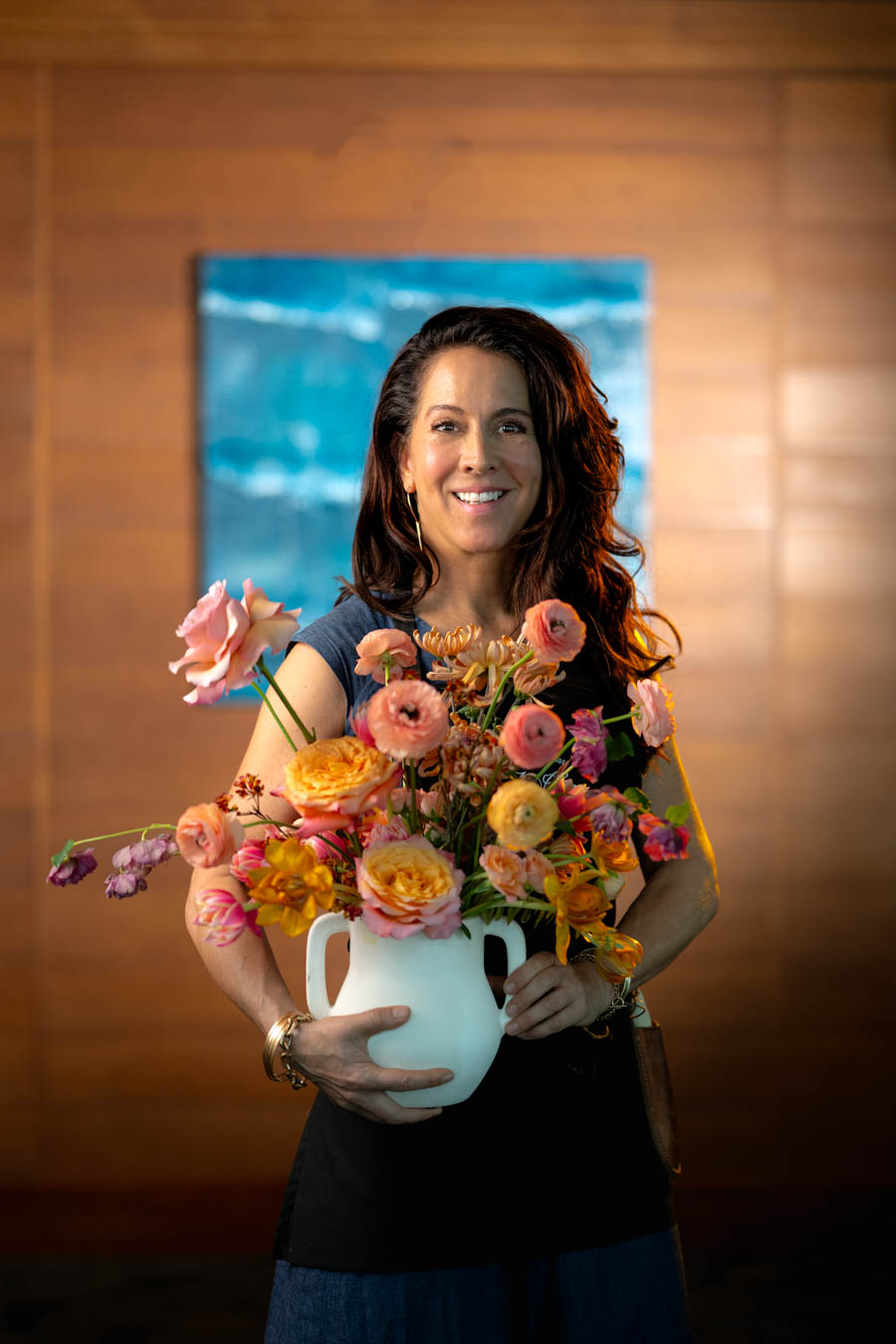In a glass vase on a table at the Sarasota Yacht Club, a stubborn stem of hellebore refuses to yield to florist Ingrid Carozzi’s efforts to coax it into another position. “A flower arrangement is like a school class of kids that always need to be smiling,” she says. “There’s always the shy one, the naughty one and the one that wants to steal all the attention. Flowers are quite special in that way.” Carozzi, a true flower whisperer, trims the wayward stem, letting it settle into its chosen position.
At Flower Talk, the Founders Garden Club of Sarasota’s annual demonstration luncheon, Carozzi plucks orange double tulips, hot pink peonies and other flowers from their designated vases to create a masterpiece of color and texture. “I want the arrangement to look like a little garden that exploded in the vase,” she adds. In 2013, Carozzi, a florist, author and teacher, founded Tin Can Studios, which has done everything from museum installations, fashion runway displays, store pop-ups, the Time 100 Most Influential People event for Time Magazine and weddings for esteemed clients like Katie Couric’s daughter.
After a decade of working with flowers, Carozzi has learned how to transform a lovely piece of nature into something even more stunning. She grew up in Stockholm, Sweden, a city built upon 17 islands. “There’s water and trees everywhere, and it’s very lush. There, you have access to the woods in a different way,” she says. “It’s not like here, where everything is a national park. Nature is for the people, so you’re out in it all the time. I think that’s one of the reasons I’m drawn to flowers without even knowing it.” Moving from Swedish forests to New York City’s urban jungle in 2000, Carozzi studied communications at Pace University and graphic design at Parsons The New School for Design, landed a role with the Swedish-American Chamber of Commerce and later became a graphic designer. While doing branding work for a company that recycled and reused salvaged wood, Carozzi received an inquiry from her former Chamber of Commerce boss, asking if she would be interested in making flower arrangements for a green summit event the chamber was hosting. “I was surprised that she was asking me because I’d never worked with flowers before. She said ‘I know you’re good with concepts and you have a great eye, and I’d like something conceptual,” she adds.
Carozzi gathered salvaged wooden crates and filled them with flowers for the event, which was attended by the King and Queen of Sweden. “There was a woman who walked into the room, and she started crying because she thought it was so beautiful, and it reminded her of the farm she grew up on in Sweden,” Carozzi says. “It struck a chord with me, and I felt that maybe this was something I should be doing.” Not wanting the event’s arrangements to go to waste, Carozzi gifted them to local cafes. A few days later, event planners and other individuals were asking her to do floral work for them. Within a year, she was featured as the Best Florist in New York Magazine and had a book deal. “I started Tin Can Studios in 2013 thinking that I’d be doing smaller events, but it turned into large-scale installations with sustainable methods,” she adds.
Tin Can Studios blossomed into existence as the floristry industry was on the cusp of a new era. “I started out ten years ago, and floristry looked different back then. It had stagnated,” Carozzi says. Symmetrical shapes, bland color palettes and a restrained use of materials had come to dominate the industry. In Brooklyn, where Tin Can Studios was born, a revolutionary movement was sprouting up. “We used a different method of arranging the flowers that’s more painterly and has an organic shape and style,” she adds. “My flowers usually spill out to the sides like a Dutch master’s still life.” Her arrangements and installations are known for their playful personalities and air of wild abandon that enraptures the viewer.
“I group different colors because I don’t like having polka dots or stripes. I tell different stories, so my arrangements are more like a book with chapters and characters. When we do flowers for events, none of the arrangements fully match each other. I say that they’re sisters, not twins. That way, your eye moves around, sees different stories and looks at all of them so that each arrangement has its own little moment,” Carozzi says. She applies her signature style to large-scale installations—like floral chandeliers and hanging displays and shares tips in her two floral design books, Handpicked and Flowers by Design.
Carozzi and her team have a vocabulary for their work, using words like headlights for two flowers that look the viewer straight in the eyes, and the term tentacles for flowers that droop down the sides of the vase, both of which are to be avoided. While budding florists need not become fluent in the jargon of the flower industry, Carozzi encourages them to adopt sustainable practices in their arrangements. “A big part of my work and company is working with sustainable methods and educating people and clients,” she adds.
Upon moving to New York, Carozzi recognized that the United States didn’t have the same culture of environmental stewardship that she’d grown up with in Sweden. “I saw entire vases going into the garbage. They would just toss the whole arrangement with the vase and everything,” she says. “I used to do a lot of salvaged and recycled vases, and lately I’ve been using more antique ones.” Along with conserving her vases, Carozzi makes every effort to use sustainable materials and methods when possible. Instead of the standard itchy green floral foam, the Tin Can Studios team fills vases with coated chicken wire, which is reusable, holds the flowers in place and allows the florists the flexibility to move them around as they create each arrangement. “If you look around the world and in this country, I would say most florists still use floral foam to keep the flowers in place, and it’s really bad for the environment,” she adds. Like floral foam, bleached and dyed flowers are also unwelcome in the studio.
“It’s one thing with clothing where you’re going to have an object for a long time, but with flowers, they’re going straight to the landfill. We compost all of our flowers, and we can’t compost bleached ones,” Carozzi says. When her team needs to add extra color to the flowers, they apply a water-based milk paint that’s 100 percent natural and organic. Even flowers without dyes and bleach can be harmful if they’re invasive species, a new hot topic in the floristry world. “As much as possible, we try to use local, seasonal flowers,” she says.
Tin Can Studios moved into a new space in Long Island City, a neighborhood in Queens, New York, where Carozzi hopes to continue teaching and building large-scale installations, with the long-term goal of growing a rooftop flower garden. She estimates that 99 percent of her work uses sustainable methods that honor the flowers’ natural beauty. “Giving and receiving a gift with flowers triggers dopamine and oxytocin, and there’s a very strong reaction when people love flowers. It’s funny how everyone has some kind of story about them. In my latest book, I feature several men, and they have these stories from their childhood about giving their teacher flowers or giving their mom a bouquet of something, even just dandelions, but they remember the feeling that flowers give. It’s magical,” she adds. “When I work with flowers, I think, ‘You’re so incredibly beautiful.’ They’re like a gift to humans, and the ephemeral quality of flowers is a reminder to live in the here and now.”










